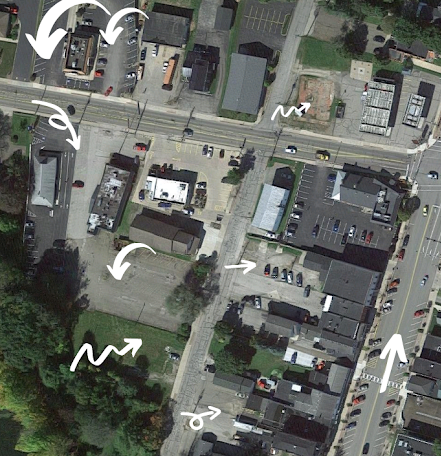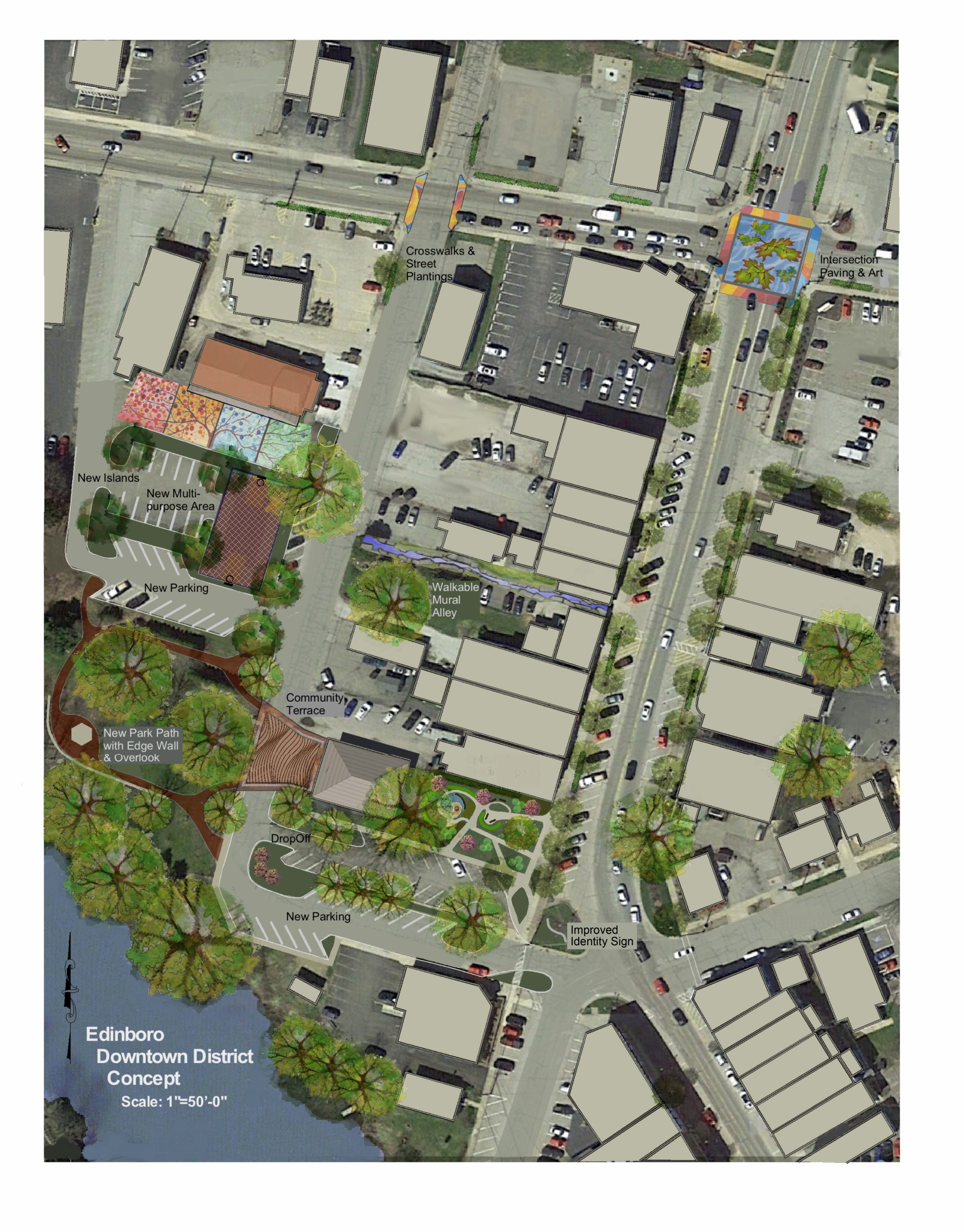Downtown District
A Place for People
A Market on Mill Street
One of the earliest ideas to emerge from the public visioning was the addition of a market to Mill Street – a shopping destination featuring an eclectic mix of indoor and outdoor shops offering fresh meat, fish, produce, coffee, wine, beer, cheese, chocolates, a variety of Pennsylvania-made products and a small cafe, to become of the borough’s most popular places to eat.
The experience
This indoor/outdoor market would serve the community through morning coffee and breakfast, daily business lunches, after-work shopping, weekend excursions with the kids, cooking classes and other fun events. The outdoor plaza would be open year-round for Christmas trees and pumpkin picking, spring garden planning and summer picnic shopping.
The opportunity
Edinboro Market, a locally owned and operated shop connecting nearby farmers and growers to the community, is already operating in a very similar fashion, though at a slightly smaller scale. Relocating to Mill Street would afford the successful shop an opportunity to expand, realizing their long-term business goals while introducing an anchor attraction to Mill Street.
Proposed reuse
Edinboro Market
- Year-round Indoor / outdoor market
- Full-service farm-to-table cafe
- Commercial kitchen for restaurant and to support local aggregation and distribution programs
- 2nd Floor Residential: potential for Chef-in-Residence program
How it works
Storefront Market + Cafe
This larger footprint would allow Edinboro Market to maintain its current service, selling seasonal, locally-sourced produce, fresh baked breads, pasture raised meats, local staples, and more, while expanding to include a full service cafe. This enhanced front-facing attraction along with an activated outdoor market and continued commitment to host events throughout the year is a timely and complementary development for the proposed improvements to Mill Street and the broader downtown district.
Commercial kitchen
The addition of a commercial kitchen and dedicated space for the aggregation and distribution of food products would support the cafe while also supporting Edinboro’s business ecosystem. The public-facing Market would continue to provide a retail experience and outlet for local distribution, while the cafe would utilize these seasonal on-hand products to inform the daily menu. This model would allow local food growers and entrepreneurs the opportunity to serve the public in a farm-to-table capacity, while simultaneously preparing and packaging their products for regional, or in some cases, national and/or international, distribution.
Skills-based Food Classes:
This valuable educational resource could continue on-site in the new location, or, given the potential increase in demand for the Market’s commercial kitchen, these classes could be hosted at the proposed Learning Kitchen slated for the nearby Town Square project. This collaborative approach would allow the Market to fulfill its commitment to food-based education while keeping the commercial kitchen dedicated to food-based business development in response to food-security initiatives.
Timeline for Implementation
Who
Current property owner(s) and Market owners
How
Negotiate a time-limited “right of first refusal” agreement with the current property owner while determining rent or purchase position. If a lease option is preferred, develop a financially-feasible lease structure to allow the Market owners to make necessary improvements to the building.
When
Q2 2021
Who
Market owners
How
- Align business plan with available square footage and associated feasibility.
- Consider complementary programming relationships (such as classes and educational workshops) with Borough’s Town Square project to alleviate demands on the commercial space.
- Consider use of second floor as pure residential, employment incentive (partial compensation for staff), or residential use connected to programming (i.e Chef-in-Residence)
Who
Market Owners
How
Identify various sources of funding to support business expansion, property acquisition (if applicable), programming, and building rehabilitation including, but not limited to private equity, historic tax credits (federal and state), federal/state grants, bank financing, charitable donations, etc.
When
Q3 2021 – Q4 2021
A great example: Capitol Market in Charleston, WV
"Celebrating over 20 years at its current location, Capitol Market has grown from a modest farmers’ market to a vibrant indoor-outdoor retail, dining and social hub open year ‘round."
Check It OutFunding
The Northwest Commission offers fixed low-interest loans, structured to allow business the ability to borrow based on the number of jobs created or retained.
Click here to learn more.
The SBA and the USDA make funds available to eligible organizations to serve as “intermediary lenders”, meaning the organizations are given money to lend under flexible terms in an effort to support business in rural communities. Reaching out to intermediaries in your area is a great way to access capital for business development.
Click here to learn more.
The Local Food Promotion Program (LFPP) funds projects that develop, coordinate and expand local and regional food business enterprises that help increase access to and availability of locally and regionally produced agricultural products.
Click here to learn more.
RBDG funding can be used to pay for commercial kitchen equipment when associated with programming to address rural community needs and underserved populations.
Click here to learn more.
Shared Parking and activated Lots
Parking is a hot button topic in most places – everyone seems to think there isn’t enough of it. In actuality, there’s an overabundance of parking in the US, an imbalance replicated in big cities and small towns across the country. Despite the facts surrounding parking availability, people continue to push for paved lots, leaving lots of empty, non-productive spaces throughout our communities. But there is opportunity in these empty spaces – room for compromise and creativity through adaptable and flexible design.
Fun Fact
The U.S. has about 2 billion off-street parking spots but only about 250 million cars
Read MoreThe experience
Off-street parking lots come in super handy during large-scale events like festivals or competitions, but more often than not in our small towns, they’re empty, or at least sparsely populated. While vacant lots contribute to “dead space” and an overall feeling of decline, well-designed lots can add vibrancy, color, shade and respite, and even a footprint for celebration and activity.
The opportunity
There’s a lot of parking in downtown Edinboro (on and off-street). It definitely doesn’t belong to the same person and it is generally intended to support adjacent businesses, so it’s not typically available for indiscriminate public use. And while that is standard practice (and sometimes policy), agreements among property owners to share parking can reduce the amount of land needed for parking, creating opportunities for more compact development, more space for pedestrian circulation, or more open space and landscaping.

Another way parking lots can contribute to economic growth is by using them for things that aren’t parking at all.
In addition to offering off-street parking, lots can be designed to serve the neighborhood when not in use by parked cars. Activating unused lots on Mill Street with pop-up events, farmers markets, pick-up basketball games, weekend “bistros” with food trucks and outdoor seating, can bring life to the neighborhood. A fun way to test this idea is to add-on to existing community events. For example, activate parking lots along Mill Street to host a Food Truck Kickoff event as a complement to the treasured Edinboro Art + Music Festival.
Thinking bigger?
Imagine downtown parking lots as buildable spaces. These lots represent opportunities for continued growth in downtown when the time is right. Efforts to support a walkable downtown district will result in more visitation and more pedestrian traffic and the demand for more retail spaces, experience or touch business, and second-story residential living will grow.
Timeline for Implementation
Who
ECED or ECED Arts and Music Committee
How
Identify property owners and reach out (preferably in person or by phone) to introduce the idea of pop-up events in the downtown district. Gauge the interest of each property owner. This exploratory process is relatively simple and free! But don’t let the cost fool you – this part is critical to planning downtown events. Establishing a personal connection not only offers first-hand perspective on their willingness to participate, but it helps you understand what options are available in your event planning.
When
Q2
Who
Borough Manager (or appropriate staff)
How
Identify two complementary-use properties within the district (adjacent, if possible) and engage in contractual agreement for a time-limited test period. Additional guidance can be found in this Best Practices Manual for Shared Parking.
When
Q2 / Q3
A great example: Model Shared Parking Ordinance
Check It OutSee the Whole Concept - An Aerial View
